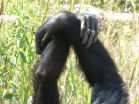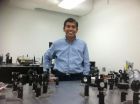(Press-News.org) Researchers at Mount Sinai School of Medicine have identified the genetic cause of a rare and fatal bone disease by studying frozen skin cells that were taken from a child with the condition almost fifty years ago. Their study, which details how the MT1-MMP gene leads to the disease known as Winchester syndrome, appears in the August 23, 2012 online edition of The American Journal of Human Genetics.
In 1969, Patricia Winchester, MD, a pediatric radiologist in New York City, was asked to diagnose two young sisters who were losing bone in their hands and feet, developing severe arthritis in their fingers and losing movement of their shoulders, elbows, hips and knees because of osteoporosis. The frozen skin cells that were recently studied by principal investigator, John Martignetti, MD, PhD, and his team of researchers in the Department of Genetics and Genomic Sciences at Mount Sinai, had been taken from one of the sisters. Ultimately, the disease rendered the girls incapable of moving without assistance, and proved fatal.
The cause of the disease has remained unknown until now, when the study's lead authors, post-doctoral students, Rebecca Mosig, PhD and Brad Evans, PhD, zeroed in on the MT1-MMP gene.
"This gene encodes an enzyme that needs to be specifically positioned on the membranes of cells to function correctly," explains Dr. Martignetti. "What we discovered is that these girls had a gene mutation which resulted in incorrect shuttling of the protein. Instead of being directed to the cell surface where it could interact with the outside environment, the mutant protein never reached its final, correct destination and remained trapped in the cell's cytoplasm. Mislocalized, it lost its ability to function and the children developed severe arthritis and bone
The enzyme lost its ability to interact with another disease-casuing protein, MMP-2. Dr. Martignetti's team had previously identifed mutations in the MMP-2 gene as the cause of a similar group of bone disorders in children.
The researchers says this recent discovery should provide diagnostic clarity and insight into possible treatments for children with Winchester syndrome, and other bone disorders, and for people in the general population who have osteoporosis and arthritis.
###
About The Mount Sinai Medical Center
The Mount Sinai Medical Center encompasses both The Mount Sinai Hospital and Mount Sinai School of Medicine. Established in 1968, Mount Sinai School of Medicine is one of the leading medical schools in the United States. The Medical School is noted for innovation in education, biomedical research, clinical care delivery, and local and global community service. It has more than 3,400 faculty in 32 departments and 14 research institutes, and ranks among the top 20 medical schools both in National Institutes of Health (NIH) funding and by U.S. News & World Report.
The Mount Sinai Hospital, founded in 1852, is a 1,171-bed tertiary- and quaternary-care teaching facility and one of the nation's oldest, largest and most-respected voluntary hospitals. In 2012, U.S. News & World Report ranked The Mount Sinai Hospital 14th on its elite Honor Roll of the nation's top hospitals based on reputation, safety, and other patient-care factors. Mount Sinai is one of 12 integrated academic medical centers whose medical school ranks among the top 20 in NIH funding and by U.S. News & World Report and whose hospital is on the U.S. News & World Report Honor Roll. Nearly 60,000 people were treated at Mount Sinai as inpatients last year, and approximately 560,000 outpatient visits took place.
For more information, visit http://www.mountsinai.org/.
Find Mount Sinai on:
Facebook: http://www.facebook.com/mountsinainyc
Twitter @mountsinainyc
YouTube: http://www.youtube.com/mountsinainy
Mount Sinai researchers solve mystery surrounding the death of two sisters nearly 50 years ago
2012-08-29
ELSE PRESS RELEASES FROM THIS DATE:
Biomass characterization technology research highlighted in Industrial Biotechnology journal
2012-08-29
New Rochelle, NY, August 29, 2012--Biomass recalcitrance--the problem of how to break down complex plant-based cellulosic feedstock into sugars that can be fermented to produce sustainable biofuels and other renewable biobased products—can be overcome through improved methods of biomass characterization. IB IN-DEPTH, a collection of articles from leading research laboratories describing advanced tools and techniques for analyzing the chemistry, structure, and interaction of biomass components, is published in Industrial Biotechnology, a peer-reviewed journal from Mary Ann ...
Chimpanzees create social traditions
2012-08-29
A research collaboration between the Gonzaga University and the Max Planck Institute shows that the way in which chimpanzees groom each other depends on the community to which they belong. Specifically, it is the unique handclasp grooming behaviour that reveals this local difference.
The specific behaviour that the researchers focused on was the 'grooming handclasp', a behaviour where two chimpanzees clasp onto each other's arms, raise those arms up in the air, and groom each other with their free arm. This behaviour has only been observed in some chimpanzee populations. ...
Breakthrough in nanotechnology
2012-08-29
A University of Central Florida assistant professor has developed a new material using nanotechnology, which could help keep pilots and sensitive equipment safe from destructive lasers.
UCF Assistant Professor Jayan Thomas, in collaboration with Carnegie Mellon University Associate Professor Rongchao Jin chronicle their work in the July issue of the journal Nano Letters. (http://dx.doi.org/10.1021/nl301988v)
Thomas is working with gold nanoparticles and studying their properties when they are shrunk into a small size regime called nanoclusters. Nanoparticles are already ...
Soaking up the Sun
2012-08-29
Solar panels, like those commonly perched atop house roofs or in sun-drenched fields, quietly harvesting the sun's radiant energy, are one of the standard-bearers of the green energy movement. But could they be better – more efficient, durable and affordable? That's what engineers from Drexel University and The University of Pennsylvania are trying to find out, with the aid of a little nanotechnology and a lot of mathematical modeling.
A three-year grant from the National Science Foundation has set the team on a track to explore ways to make new photoelectric cells more ...
TacSat-4 participates in Navy fleet experiment Trident Warrior
2012-08-29
WASHINGTON –- U.S. Naval Research Laboratory's Tactical Satellite-4 successfully completes three weeks of intense testing, June 28, as part of the Navy's annual Trident Warrior Experiment 2012 (TW12). TacSat-4 is a Navy-led Joint mission that provides Ultra High Frequency (UHF) satellite communications (SATCOM).
Sponsored by Navy Warfare Development Command, Trident Warrior is an annual fleet experiment focused on gaining valuable insights to improve future capability investments. This year's agenda included at-sea experimentation of critical maritime initiatives, and ...
Many trendy 'microgreens' are more nutritious than their mature counterparts
2012-08-29
The first scientific analysis of nutrient levels in edible microgreens has found that many of those trendy seedlings of green vegetables and herbs have more vitamins and healthful nutrients than their fully grown counterparts. A report on the research appears in ACS' Journal of Agricultural and Food Chemistry.
Qin Wang, Gene E. Lester and colleagues point out that microgreens have gained popularity as a new culinary trend over the past few years, especially in upscale markets and restaurants. Those seedlings of spinach, lettuce, red cabbage and other veggies are usually ...
Warning on deterioration of famous Swedish warship, Vasa
2012-08-29
The famous warship, Vasa, displayed in a museum that gets 1.2 million visitors every year and ranks as one of Sweden's most popular tourist attractions, is deteriorating despite ongoing preservation efforts, scientists are reporting. Their study, citing a "significant" loss of strength in the ship's wood, appears in ACS' journal Biomacromolecules.
Ingela Bjurhager, Lars A. Berglund and colleagues explain that the Vasa sunk in the Stockholm harbor in 1628 on its maiden voyage after sailing less than a nautical mile. The ship was rediscovered in 1958, raised in 1961, treated ...
New antibacterial coating for sutures could reduce infections after surgery
2012-08-29
Responding to an urgent need for better antibacterial coatings on surgical sutures, scientists are reporting the discovery of a new coating that is almost 1,000 times more effective than the most widely used commercial coating. Their report appears in ACS' journal Langmuir.
Professor Gregory Tew, who is from UMass-Amherst, and colleagues explain that infection at the site of surgical incisions is one of the most common post-surgical complications that keep patients hospitalized longer and boost hospital bills. The most common antibiotic coating contains triclosan, but ...
A new approach for controlling the skyrocketing cost of health care
2012-08-29
A potentially powerful new approach for limiting health care costs — which account for almost $1 out of every $5 spent in the U.S. each year — is the topic of the feature story in this week's edition of Chemical & Enginering News (C&EN), the weekly news magazine of the American Chemical Society (ACS), the world's largest scientific society.
C&EN Senior Correspondent Marc S. Reisch explains that one until-now neglected way to reign in health care spending involves providing patients and doctors with better diagnostic tests. Such tests could save money by providing greater ...
URI oceanographers find there is one-third less life on Earth
2012-08-29
NARRAGANSETT, R.I. – August 29, 2012 -- Estimates of the total mass of all life on Earth should be reduced by about one third, based on the results of a study by a team of scientists at the University of Rhode Island's Graduate School of Oceanography and colleagues in Germany.
The research was published this week in the Proceedings of the National Academy of Science.
According to previous estimates, about one thousand billion tons of carbon is stored in living organisms, of which 30 percent is in single-cell microbes in the ocean floor and 55 percent reside in land ...


